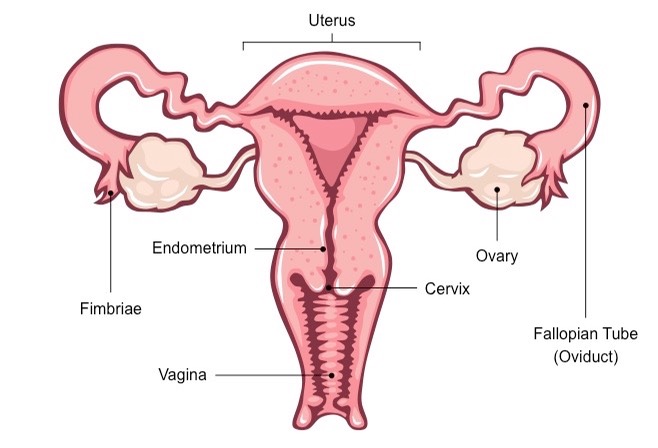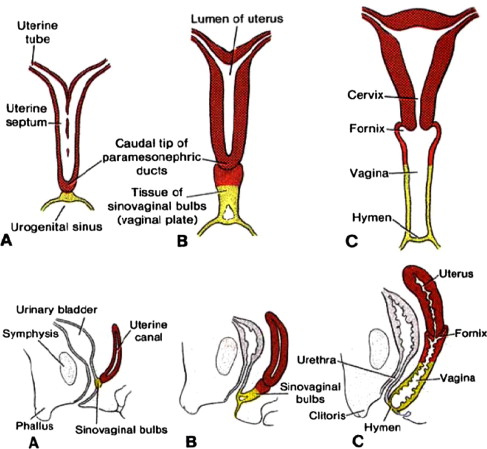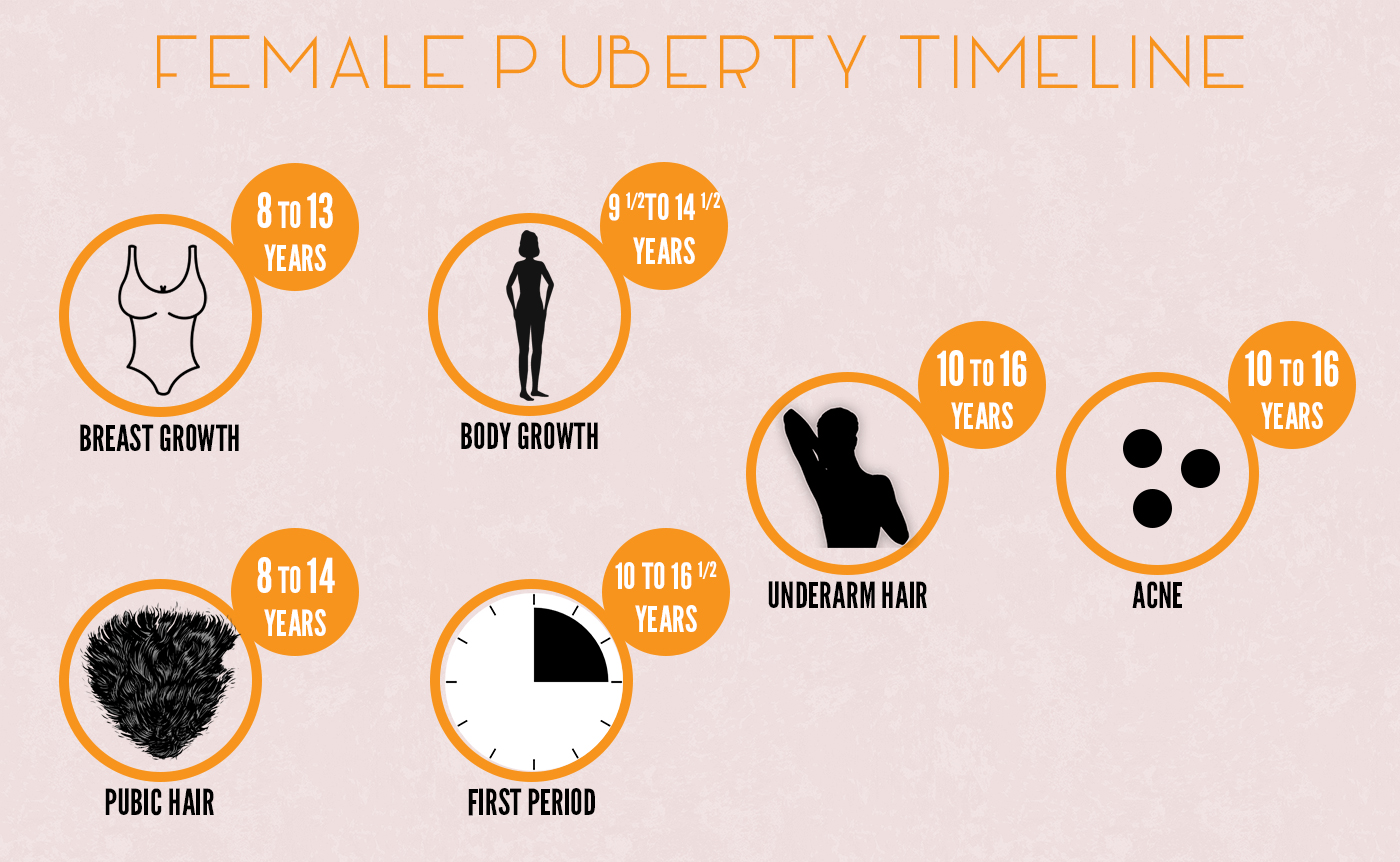Female Reproductive Development Study Guide
Introduction
The presence of a Y or X chromosome guides sexual development and the determination of reproductive system organs. In other words, we are often genetically programmed to grow as either a male or female embryo after conception.
- Before differentiating into the testes and ovaries, the sex glands go through an indifferent period.
- The presence or lack of testosterone impacts the sexual differentiation of the genital ducts.
- Hormonal secretions (or lack thereof) have a role in the sexual differentiation of the external genital organs.
Development of female reproductive organs
Gonads:
- The testes and ovaries develop from the primitive gonads (sex organs).
- In the early stage of embryonic development, sex organs cannot be visually distinguished as testes or ovaries.
- In females, lack of testosterone is responsible for the development of the ovaries instead of the testes.
- In the ovaries, the first germ cell differentiates into oogonia, entering the first meiotic division. However, the meiotic division is arrested in the metaphase stage and remains in this condition until puberty.
Genital ducts:
- Initially, both males and females possess two sets of genital ducts – the mesonephric and paramesonephric ducts.
- The lack of Sertoli cells and Leydig cells are primarily responsible for the differentiation of the female genital ducts.
- The mesonephric ducts and tubules degenerate rapidly in the absence of the hormone testosterone.
- The development of the paramesonephric duct gives rise to a pair of ovaries and this is induced in the presence of the AMH (anti-müllerian hormone) hormone. AMH plays an important role in the development of sex organs in an unborn baby.
- Furthermore, the presence of the female reproductive hormone estrogen promotes the development of the paramesonephric ducts.
External genitalia:
The genital tubercle does not enlarge in the absence of the fetal testes and their hormonal secretions. Instead, the clitoris is formed. The labia minora is formed by the urethral folds, whereas the labia majora is formed by the genital swellings.
So far, we have discussed the development of primary sexual organs and their accessory duct. But complete sexual maturity occurs only after an overall development of primary sexual organs and secondary sexual characters.
This development phase in an individual’s life generally occurs after puberty. Puberty is linked to the emergence of secondary sexual characters and rapid growth. The onset of puberty differs from person to person. In girls, it starts around the age of 10-14.
The first sign of puberty in females is
- The enlargement of breasts
- Growth of pubic hair and growth of armpits hair
- Menstruation also starts in girls after puberty, generally after the physical changes
The onset of menstruation or first menstruation is known as menarche. However, the menstrual cycle frequency remains irregular for a couple of years after its onset. About 2-4 years after puberty, regular ovulation starts in girls.
Other changes during puberty:
- Puberty is frequently accompanied by a sudden rise in height, known as a growth spurt. This fast height gain lasts two to three years on average.
- Puberty accounts for about 17 to 18% of adult height. Although both the trunk and the limbs are affected by height gain, the limbs normally expand first.
- Puberty causes bone growth and density to rise. After peak height growth, bone mineralization peaks in girls around menstrual cycles (growth spurt).
- As research suggests, bone width rises first, then bone mineral content, and finally bone density.
- Weight and body composition change during this time. Adolescent females have a higher proportion of body fat than boys, with fat redistribution toward the upper and lower bodies curvier.
- Maturation of the cardiovascular and respiratory systems leads to the greater functional capacity of these organs and an improvement in total endurance and strength.
- An increase in emotional intelligence also marks this period.
- Adolescents become self-conscious. The hormonal fluctuations can also trigger mood swings, anxiety, and depression.
Conclusion:
- Most of the primary organs of females are developed in the fetal stage.
- However, sexual maturity (complete development of female reproductive system) is attained only after puberty during when secondary sexual characters also develop.
FAQs:
1. When is the female reproductive system fully developed?
Puberty is associated with many changes in the physical body, including the development of secondary sexual characters. Two obvious changes in girls in puberty are an enlargement of breasts and the growth of pubic hair. This development period of the female reproductive system generally starts around age 10-11 and continues till around age 14-15.
2. What is the development aspect of the reproductive system?
Up to the sixth week of fetal development, the genital system remains the same. The lack of anti-Mullerian hormone (AMH) and the SRY gene causes Wolffian duct regression and greater differentiation of Mullerian ducts in females. A vertical fusion of paramesonephric ducts occurs in the eighth week.
The left and right sections of what would eventually become the uterus originate from the united cranial end. The endometrium and myometrium will be formed from the mesoderm in this structure. The fallopian tubes originate from the unfused cranial ends of the Mullerian ducts; the fimbrial section of the fallopian tubes develops from the tip of this structure, which remains open and takes on a funnel shape.
The upper section of the vagina will be formed by the caudal end of the united ducts. The uterus and other tissues generated from the Mullerian ducts are fully developed by the end of the first trimester.
3. At what age is the uterus fully developed?
The uterus is developed fully during embryological development. However, during puberty, the uterus increases in size, and its shape change from tubular form to the pear-shaped organ. This development is completed by around the age of 14-15.
4. What are the 4 female reproductive disorders?
- Polycystic Ovary Syndrome
- Endometriosis.
- Uterine Fibroids.
- Interstitial Cystitis
5. How can an individual become infertile?
- With age, both the quantity and quality of eggs gradually decrease.
- Smoking
- Alcohol consumption
- Hormonal imbalances
- Sexually transmitted diseases like chlamydia and gonorrhea can also cause infertility.
- Genetic conditions like turner’s syndrome.
- Temporary infertility: during the existing pregnancy, lactational period, side effects of certain drugs can cause temporary infertility in females.
6. What are the 5 main parts of the female reproductive system?
- Ovaries
- Fallopian tube
- Uterus
- Cervix
- Vagina
We hope you enjoyed studying this lesson and learned something cool about Female Reproductive Development! Join our Discord community to get any questions you may have answered and to engage with other students just like you!Don’t forget to download our App to experience our fun, VR classrooms – we promise, it makes studying much more fun!😎
Sources:
- Chapter 22: Reproductive Development & Function of the Female Reproductive System. https://accessmedicine.mhmedical.com/content.aspx?bookid=1587§ionid=97164484. Accessed on 29 Nov, 2021.
- Female Reproductive Development. https://flexbooks.ck12.org/cbook/ck-12-biology-flexbook-2.0/section/13.62/primary/lesson/female-reproductive-development-bio/. Accessed on 29 Nov, 2021.
- Female Reproductive System. https://kidshealth.org/en/parents/female-reproductive-system.html. Accessed on 29 Nov, 2021.



